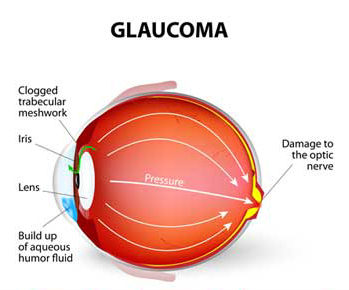Glaucoma is a group of diseases that damage the eye’s optic nerve and can result in vision loss and blindness. It is the second leading cause of blindness in America. There is no cure for glaucoma. Vision loss from the disease is permanent. Someone with glaucoma may not feel any pain or have any other outward symptoms but just suffer the slow loss of vision.
Anyone can develop glaucoma. Some people are at higher risk than others, including anyone over 60 years of age, those with diabetes, and patients with a family history of glaucoma. For certain patients at high risk, eye drops can reduce the risk of developing glaucoma by half.

The optic nerve plays a close role in whether glaucoma becomes a problem or not. This nerve is a bundle of more than 1 million nerve fibers. It connects the retina to the brain. A healthy optic nerve is necessary for good vision. Several large studies have shown that eye pressure is a major risk factor for optic nerve damage. Whether someone develops glaucoma depends on the level of pressure their optic nerve can tolerate without being damaged. This level is different for each person. That’s why a comprehensive dilated eye exam is very important. It can help an eye care professional determine what level of eye pressure is normal for each patient. With early detection and treatment, patients can often protect their eyes against serious vision loss from glaucoma.
HOW IS GLAUCOMA DETECTED?
According to the National Eye Institute, glaucoma is detected through a comprehensive dilated eye exam that includes the following:
Visual acuity test: This eye chart test measures how well a patient can see at various distances.
Visual field test: This test measures peripheral (side vision).
Dilated eye exam: In this exam, drops are placed in the eyes to widen, or dilate, the pupils. An eye care professional uses a special magnifying lens to examine the retina and optic nerve for signs of damage and other eye problems.
Tonometry: A measurement of pressure inside the eye by using an instrument called a tonometer. Numbing drops may be applied to the eye for this test. A tonometer measures pressure inside the eye to detect glaucoma. Periodic testing is required because the pressure can change over time.
Pachymetry: A measurement of the thickness of your cornea. For this, an eye care professional applies a numbing drop to the eye and uses an ultrasonic wave instrument to measure the thickness of your cornea.
GLAUCOMA TREATMENT
Medicines, in the form of eye drops or pills, are the most common early treatment for glaucoma. Taken regularly, these eye drops lower eye pressure. Some medicines cause the eye to make less fluid. Others lower pressure by helping fluid drain from the eye.
SOURCES FOR THIS MATERIAL: National Eye Institute, Mayo Clinic, American Optometric Association
